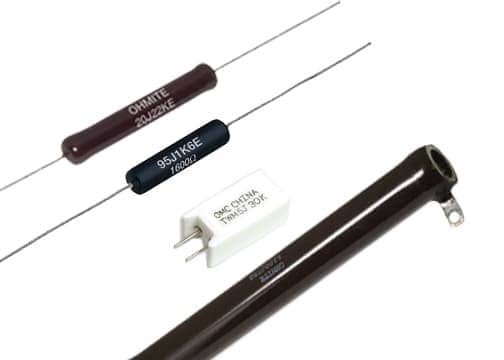Guide to Wirewound Resistors
Wirewound resistors, revered for their precision, stability, and high-power handling capabilities, stand as stalwart components in the realm of electrical engineering. Their robust construction and precise resistance values make them indispensable in a myriad of applications, from power electronics to precision instrumentation. On this page, we'll embark on a journey to explore everything engineers should know about wirewound resistors, from their construction and characteristics to their applications and selection considerations.
Understanding Wirewound Resistors
Construction
Wirewound resistors consist of a resistive wire, typically made of materials such as nichrome or constantan, wound around a ceramic or fiberglass core. The resistive wire is wound in a helical or spiral pattern, providing precise resistance values and high power dissipation capabilities.
Characteristics
Wirewound resistors exhibit excellent stability, low temperature coefficients of resistance (TCR), and high precision, making them ideal for applications requiring accurate resistance values. They offer high power handling capacities and are capable of dissipating significant amounts of heat without compromising performance.
Temperature Coefficient of Resistance (TCR)
The TCR of wirewound resistors is typically low, ensuring minimal resistance drift over temperature variations. Low TCR values make wirewound resistors suitable for applications requiring stable performance across varying operating temperatures.
Precision and Tolerance
Wirewound resistors provide precise resistance values with tight tolerances, typically ranging from ±1% to ±5%. High precision and tolerance levels ensure accurate and consistent performance in critical electronic circuits.
Applications of Wirewound Resistors
Power Electronics
Wirewound resistors are extensively used in power electronics applications such as power supplies, voltage regulators, and motor drives. Their high power handling capacity and stability make them ideal for dissipating heat and providing precise resistance in power circuits.
Precision Instrumentation
Wirewound resistors find applications in precision instrumentation and measurement equipment, where accuracy and stability are paramount. They provide precise resistance values with minimal drift, ensuring reliable performance in sensitive electronic circuits.
High-Frequency Applications
Wirewound resistors are suitable for high-frequency applications such as RF (radio frequency) circuits, telecommunications equipment, and antenna matching networks. Their low inductance and high-frequency response make them well-suited for impedance matching and signal conditioning in RF circuits.
Temperature Sensing and Control
Wirewound resistors are utilized in temperature sensing and control systems, where they act as temperature sensors or heating elements. Their stable resistance values and low TCR enable accurate temperature measurements and precise control of heating systems.
Considerations for Selecting a Wirewound Resistor
Resistance Value and Tolerance
Choose wirewound resistors with resistance values and tolerances that meet the requirements of the application. Consider factors such as precision, stability, and tolerance level when selecting the appropriate resistor.
Power Rating
Select wirewound resistors with power ratings compatible with the expected power dissipation in the circuit. Ensure that the chosen resistor can handle the maximum power without overheating or compromising performance.
Temperature Coefficient
Consider the temperature coefficient of resistance (TCR) when selecting wirewound resistors for applications with wide temperature ranges. Opt for resistors with low TCR values to minimize resistance variation over temperature changes.
Size and Mounting
Evaluate the physical dimensions and mounting options of wirewound resistors to ensure compatibility with the circuit layout and space constraints. Choose resistors with appropriate package sizes and mounting configurations for easy integration into the design.
Environmental Considerations
Assess the environmental conditions of the application, including temperature, humidity, and vibration, and select wirewound resistors with suitable ratings for reliable operation.
Conclusion
Wirewound resistors epitomize precision, stability, and reliability in the world of electronics, offering engineers a robust solution for a wide range of applications. From power electronics and precision instrumentation to RF circuits and temperature control systems, wirewound resistors find applications in diverse fields. By understanding their construction, characteristics, applications, and selection considerations, engineers can harness the full potential of wirewound resistors to design innovative and dependable electronic systems with confidence.

Blog
Read More
Guide to Power Resistors
Power resistors are used to dissipate energy by converting it to heat. and are designed to maintain stable performance. Call now and request a quote today!
Read More
Guide to Ceramic Resistors
Ceramic Composition resistors are composed of a mixture of a finely ground insulator and conductor which is compressed into a cylindrical shape. Call now!
Read More
Guide to Heat Sinks
As semiconductor devices scale to smaller sizes and higher power densities, thermal management has become more challenging Call now and request a quote!
Read More
Guide to Load Banks
A load bank is a device that is intended to accurately mimic a load that a power source will see in an actual application. Call now and request a quote today!
Read More
Guide to EMI Filters
To control the effects of EMI, standards are in place internationally, for commercial electronics, aerospace as well as military and space applications. Call now!
Read More
Guide to Rheostats
Rheostats, a fundamental component in electrical engineering, play a crucial role in controlling current flow and adjusting resistance in electrical circuits. Call now!
Read More
Guide to Thick Film Resistors
Thick film resistors, hailed for their versatility, durability, and wide-ranging applications, are a cornerstone of modern electronics. Call now and request a quote!
Read More
Ohms' Law Calculator
Read More
Ohm's Law 101
Ohm's Law stands as one of the fundamental principles in electrical engineering, providing a cornerstone for understanding and analyzing electrical circuits. Call now!
Read More
Energy Rating Calculator
Read More
Media Library
Read More
Technical Information
Read More
Industrial Resources
As a manufacturer of power resistors, Ohmite often creates products designed for industrial applications.
Read More
Medical Resources
As a manufacturer of power resistors, Ohmite often creates products designed for medical applications.
Read More
Transportation Resources
As a manufacturer of power resistors, Ohmite often creates products designed for transportation applications.
Read More
Military & Aerospace Resources
As a manufacturer of power resistors, Ohmite often creates products designed for military and aerospace applications.
Read More

